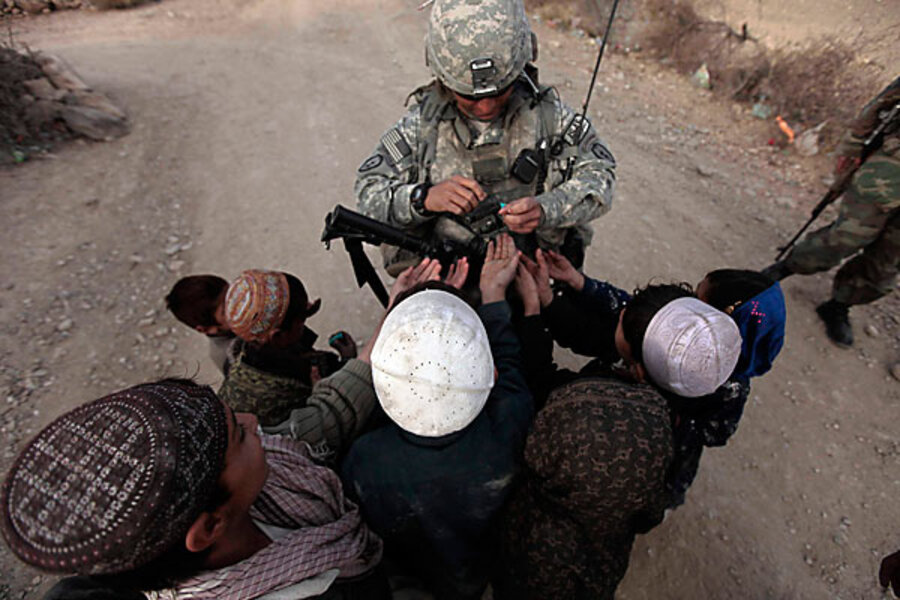Afghanistan war: What success will look like
Loading...
| Washington
As President Obama directs 30,000 additional forces into Afghanistan over the next eight months, it’s still unclear what “finishing the job” will look like.
Richard Holbrooke, US special envoy to Afghanistan and Pakistan, quipped that “you’ll know it when you see it.” That vague forecast left lawmakers cold, but Mr. Obama never used the word “victory” in his Dec. 1 Afghanistan speech in part because success will likely be nuanced.
The administration has dramatically pared back the idealistic goals pursued by the Bush administration – robust democracy, human rights, and a free-market economy – to the practical essentials:
•Deny Al Qaeda from regaining a haven in Afghanistan; disrupt, dismantle, and defeat it in Pakistan.
•Build the Afghan security forces to the point that they can maintain a reasonable level of security in Afghanistan.
•Degrade the Taliban insurgency to the point that Afghans can manage it.
•Curtail rampant Afghan corruption so that the government can begin to meet the most basic needs of its people.
“Progress towards each of those [is] important,” says Michael Vickers, assistant secretary of Defense for Special Operations and Low Intensity Conflict at the Pentagon.
Achieving that will allow Obama to meet a primary goal of his new strategy: begin drawing down forces by July 2011.
To that end, Defense Secretary Robert Gates has said the new strategy will be assessed monthly and, in December 2010, will get a fundamental reexamination.
But finding “metrics” – the Beltway’s word for data that measure progress toward these goals – is problematic. The administration has yet to provide specifics about the metrics it plans to use.
Appearing on Capitol Hill the day after Obama announced the new strategy, Mr. Gates told lawmakers the administration had benchmarks on Afghan force recruitment, retention, fielding, and partnering, for example, but didn’t elaborate.
“The president’s made it pretty clear ... that he’s expecting to get monthly reports on how we’re doing against these,” Gates said.
Demand for metrics
But a war-weary public will also demand transparency. Metrics or benchmarks, said Sen. Ben Nelson (D) of Nebraska, are critical to the public’s understanding of the war.
“That is critically important to not only determining how we’re doing, but also, I think, in keeping the American people in seeing that progress is in fact being made, and where it isn’t – that a plan is now in place to try to change the direction,” he said.
Such metrics can run the gamut from the number of people employed to how many farmers can safely bring their crop to market or how many insurgents have been killed. Some metrics are classified – such as the amount of actionable intelligence gained from the population.
When it comes to metrics assessing progress, the mission in Afghanistan has long suffered compared with the mission in Iraq. Congress mandated that the Bush administration compile a quarterly report on Iraq that included dozens of pages of data, maps, charts, and narratives.
Although the information was often criticized for being irrelevant and out of date – and the reports themselves were typically late – it did provide a snapshot of how effective American policy was in the country. No such thing existed for Afghanistan until this year.
But those twice-yearly reports are lacking, says Anthony Cordesman, an analyst at the Center for Strategic and International Studies in Washington.
Economic data are insufficient, and there is virtually no useful measure of effectiveness for the Afghan government, he said. Information on the growth of the Afghan security forces is also misleading: For example, manpower attrition rates, which can be high, were not in the reporting.
“There haven’t been any meaningful metrics coming out of the executive branch since May,” says Mr. Cordesman. “If we do not understand where we’ve been, where we are, and where we are going, and we cannot provide simplified ranges of material, what we are saying is that everything we are doing is based on ignorance.”
Earlier this year, the administration created a list of data points and maps color-coded to show Congress how the United States was doing in Afghanistan. The “Strategic Implementation Plan,” or SIP, was developed to provide more details that included nine broad objectives and more than 50 criteria. But the White House has kept them under wraps.
White House officials will soon begin updating those metrics, but it’s unclear if they will be made public.
Measuring success not a science
Ultimately, Mr. Holbrooke may be right. Measures of success will come as narratives and indicators will be more art than science.
One example could already be found in eastern Afghanistan, where the senior enlisted US adviser there tells the story of how allied troops killed insurgents who had been planting bombs along the roadside – bombs that were preventing locals from accessing a local market. With the bombs gone, the market prospered.
“With their own assets, their own hands and their own will, the locals expanded existing businesses and opened new ones, heartened by their newfound sense of security,” Sgt. Maj. Michael Hall wrote on a blog post from Afghanistan.
---
Follow us on Twitter.





